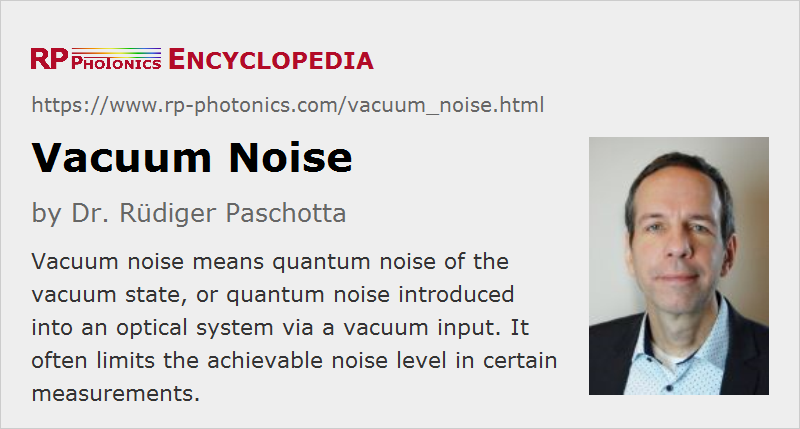Vacuum Noise
Definition: quantum noise of the vacuum state, or quantum noise introduced into an optical system via a vacuum input
German: Vakuumfluktuationen
Categories:  quantum optics,
quantum optics,  fluctuations and noise
fluctuations and noise
Author: Dr. Rüdiger Paschotta
Cite the article using its DOI: https://doi.org/10.61835/twq
Get citation code: Endnote (RIS) BibTex plain textHTML
Vacuum noise is quantum noise related to the zero-point fluctuations of the electric field in the vacuum state. Such fluctuations exist even though the vacuum state has a photon number of zero.

Despite being fairly weak, vacuum noise can significantly affect the noise properties or even the essential function of optical devices. For example, parametric generation can be considered as the effect of amplifying vacuum noise to macroscopic power levels in a high-gain optical parametric amplifier. Also, the process of spontaneous emission can (in a semiclassical picture) be interpreted as being stimulated by vacuum noise.
Any linear losses acting on a light beam introduce vacuum noise, rather than simply attenuating the quantum noise together with the average amplitude. This is most obvious for attenuation with a beam splitter, which can be understood to mix a portion of the input beam with vacuum noise from the unused input port (Figure 1). However, vacuum noise is also introduced by any other kind of linear attenuation, e.g. via absorption in a medium. In effect, linear attenuation brings, e.g., squeezed light closer to a coherent state.
More to Learn
Encyclopedia articles:
Blog articles:
Questions and Comments from Users
Here you can submit questions and comments. As far as they get accepted by the author, they will appear above this paragraph together with the author’s answer. The author will decide on acceptance based on certain criteria. Essentially, the issue must be of sufficiently broad interest.
Please do not enter personal data here; we would otherwise delete it soon. (See also our privacy declaration.) If you wish to receive personal feedback or consultancy from the author, please contact him, e.g. via e-mail.
By submitting the information, you give your consent to the potential publication of your inputs on our website according to our rules. (If you later retract your consent, we will delete those inputs.) As your inputs are first reviewed by the author, they may be published with some delay.





2023-06-23
In Fig. 1, when the vacuum noise enters the open port to the downward direction, does vacuum noise also enter on the right side?
The author's answer:
Sure, it does. Only, that won't be relevant for the two shown outputs.